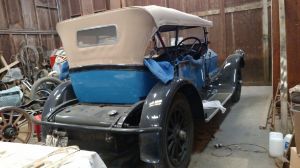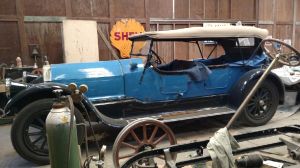- Home
- About Us
- Join/Renew
- Member Benefits
- Member Pages
- Log In
- Help
- Museum Store
Peter, you MAY have an aperture on the right rear vertical portion of your cylinder head in which a bulb-type fitting could be inserted.
I haven’t installed mine yet but am delighted to hear excellent reports of this project’s performance.
This was the PERFECT project: a very rare, critical part which improves the performance of many of our cars. Well thought out, perfectly executed! Congratulations, John and PAF!
WHAT’S NEXT???? 
George
A real gentleman and the consummate PAS participant and supporter, Fred will be deeply missed and fondly remembered by all of us.
George
Edit to my post immediately above: The *cylinder block* was cast as a unit 1921-28, and bolted to a cast aluminum crankcase–replacing cylinders cast in pairs.
Arguably, “Postwar Changes” should cover the model years 1921-1928. “The Second Decade” may need a rename and should run through 1920 (Series 31 & 51), as the 1920 models are a continuation of bodies and engines from 1914 and before. The Series 32 for 1921 had new bodies, left hand steering, and a monoblock engine.
Dave, no, the auction house does not have a car dealer license so DMV will collect use tax when I transfer the trailer.
Our late member Jack Passey, while heading the Association of California Car Clubs, was able to secure a provision exempting collector cars, defined as 25 or more model years old, from the requirement for registering such vehicles as “Non-Ops.” See the California Vehicle Code (CVC) in the 5000 series. Nevertheles, one must still execute a Certification of Non-Operation when one registers the car for the road for the first time, and this can be a hassle as DMV employees are usually unaware of this provision. Nor is their Operations Manual keyed to numbered sections of the CVC. I once was told by a DMV Field Office manager, “we don’t follow the CVC, we have our own rules.” I replied that the legislature enacts the CVC and the DMV is required to implement the CVC provisions in their own regulations. I then immediately telephoned the DMV Public Inquiries Unit (916-657-6560)and they counseled the manager…. No triumph over DMV is a minor victory! 
I’ve found it’s best to inquire of the DMV Public Inquiries Unit *before* visiting a field office and to ask Public Inquiries for a chapter-and-verse reference to the field offices’ operations manual. The clerk can key in that reference at their work station and solve the problem quickly.
I believe that each field office should have at least one employee who is familiar with issues such as Historical Vehicle or Horseless Carriage license plates and other collector-car issues, but DMV does not share my opinion.
Dave, you can probably apply for a refund of the $4500 in fines. For everyone else, California does indeed hold the buyer responsible for the sins of previous owners.
I attended the auction (and bought the extra-tall car trailer).
The 1919 Series 51 was purchased by a California PAS member who does not (as far as I know) participate in this forum. He is an active restorer of several makes and tours his cars regularly.
Despite the body crafted in the 1960s or earlier (there are tour plaques from 1963 and 1967 affixed to the wooded trim underneath the non-original windshield frame), the subject Series 51 remains an outstanding tour car and is probably lighter than one with a factory body.
Let me clarify Greg’s reference to “California’s special sales tax on vehicles”: Here in The People’s Republik, if one buys a vehicle from a dealer, the dealer collects sales tax at the same rate as if one were buying shoes (including the basic state rate, city and county and special programs approved by the voters) and forwards it to the state. If one purchases ANY vehicle (including nearly new ones) from a private party or an auction, at ownership transfer California DMV collects a “use tax” in lieu of sales tax (“a [stinky] rose by any other name”) based on the address of the new owner. In my case, sales tax and the use tax rate is 10%, the rate including the basic state rate of 7%, plus add-ons for the City of San Leandro, Alameda County, BART light rail, and other voter-approved add-ons. Yes, it’s a real bite. On the other hand, we benefit from the “Prop 13” restriction on real estate taxes enacted in 1978, which rewards those (like me) who remain in properties purchased long ago.
another recent photo, resized

(finally) resized photo

I have photos that will have to be resized before this site will accept them. Don’t have time for a couple of days. If you’re interested, please email me directly.
This is a No-Reserve auction. (I have no personal interest in the car, and am adding this information to help Al, who does not use a computer.)
I’ve added a more specific link to the vehicles.
Liquidation of this car and other collector vehicles will be held at Jerry Gould Auction Company, Bakersfield, CA at 9:00 AM PDT on Saturday July 23, 2016, telephone bids accepted. Preview is Friday July 22 9:00 AM to 4:00 PM at 6200 Price Way, Bakersfield, CA. For details on the AUCTION including bidding and payment requirements, call Gould Auction at (559) 587-3123 during business hours. For information on the VEHICLES, call PAS member Al Engel at (559) 688-8844, the sooner the better.
The auction company has NOT been responsive to questions and requests for more information I submitted via their website, two weeks apart, so I recommend telephone as the only means of getting more information. I am told that TELEPHONE BIDS will be accepted, but there is no information on the website about bidder qualification and payment requirements. Note when going to website that this company is gouldauction.com (singular), and that a completely different company is gouldauctions.com (plural of auction)
I was allowed to drive this Series 51 on the 2008 Modoc Tour and found it to be an excellent performer.
Other vehicles being auctioned include 1911 Kissel 40 hp model D-11, 1968 Dodge Coronet 426 Hemi 4-speed restored, enclosed car trailer, 2006 Dodge Cummins diesel dually pickup tow vehicle, 1979 Mercedes 450SL, vintage motorcycles.
To attempt to answer questions about the body: I understand that now deceased member John Libaire’s 66 touring caught fire and the body was lost but not the chassis. He constructed, or had constructed, this 4-p phaeton body for his 66. At some later date, he acquired a 1919 Series 51 touring and mounted the 51 body on the 66 chassis, and this body on the 51 chassis.
http://gouldauction.com/index.cfm?fuseaction=projectGallery&action=listing&listing=3
In the URL below, scroll down to Pierce-Arrow. The SECOND item is the serial number plate, appropriate for 1929-38. Very inexpensive at $17.95 + 15% shipping.
This is a project of the Southern California Region of CCCA.
Congratulations once again, Roger! Highly deserved!
I think Oivind’s guess that the lack of mounting holes suggests that the fenders could be used on several different models with the local shop drilling holes as needed for the specific application.
I counted the many RF fenders (PAMCC called them “guards”) with integral headlight housings for 48-B-5, and found **17* different unpainted ones, and *13* different painted fenders. Cars with fender wells, or Westinghouse air springs, or both were ssome of the variables.
I am sure that these fenders will be an easy sale! They must NOT be scrapped!
Fantastic find! I just checked my photocopy of a 1918 48-B-5 parts list and was surprised to find how many different RF (right front) fenders were available, including different units for cars equipped with Westinghouse air shocks. The closest number is 46695 (four digits off), and most are in the 50nnnn series.
I’ll hazard a guess that this is a 4th series (1916-18) fender, but could be 38/48/66.
Or use a Model A or Model T monkey wrench with relatively thin “fingers”” on the jaw. That’s what I carry and it works for many other applications as well”
Jim, those zerk fitting mods can be dangerous–a lever action grease gun exerts about 3000 psi pressure which may blow any mechanical seals inside, as on a Cadillac flathead V8, not a S80/81 unless seals have been added. Cads and other cars with factory zerks on water pumps also came with a twist-knob-operated grease gun specifically for that purpose.
Ken, try to disassemble –GENTLY–that grease cup assembly. Suggest soaking it in lacquer thinner overnight. Grease cup may have been super-glued together–hope not. I wonder whether your pump–and the grease cup–have been modified in the past.
Ken, I should have been more specific in my description. Often a slightly different-from-original grease cup is found, but the following will work for both.
The grease cup actually has two parts: the heavier portion is screwed into the water pump housing; the flats are either 3/8 or 7/16 inch. LEAVE THIS PART IN PLACE The upper part has a knurled circumference OR (different type) a raised straight section to five you a finger grip. The upper portion of either type unscrews easily with your fingers.
Screwing down the easily-removable part with your thumb and forefinger forces a small amount of grease through the hole in the (heavier) base into the pump–that is, until the supply of grease in the ‘reservoir’ has been used up, at which time you need to re-pack.
The idea is to fill the reservoir but allow just enough unfilled space for the threads on the two parts to gain traction. Whether you fill the base (lower) or upper portion doesn’t make much difference. As a general rule, if the threads of the base are on the outside, fill the base–and vice versa.
George
Unscrew and remove the grease cup. Clean out any old grease inside, Use your fingertip to pack the grease cup to within 3 or 4 threads of the open end. Screw grease cup onto the threads. Stop when you get moderate resistance after the grease compresses a bit, it’s not supposed to be tight. By no means use a tool to tighten! From time to time (maybe every couple of hundred miles OR if you see some dripping), give the cup a half turn or so. When you get a lot of resistance, it’s time to refill the cup. That’s all there is to it!
Bill, I note on that webpage that that grease is NLGI Grade #!, not #4. Do we have any lubrication engineers familiar with NLGI grades?
George
